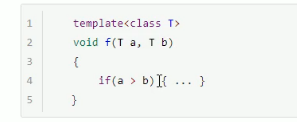~~
局限性:
~~
*
模板的通用性并不是万能的
例如:

在上述代码中提供的赋值操作,入过传入的a和b是一个数组,就无法实现了
再例如:

在上述代码中,如果T的数据类型传入的是象Person这样的自定义数据类型,也无法正常运行
因此C++为了解决这种问题,提供模板的重载,可以为这些特定的类型提供具体化的模板
代码示例:
#include<iostream>
#include <string>
using namespace std;
//模板的局限性
//模板并不是万能的,有些特定数据类型,需要具体话方式做特殊实现
class Person
{
public:
Person(string name, int age)
{
this->m_Name = name;
this->m_Age = age;
}
string m_Name;
int m_Age;
};
//对比两个数据是否相等函数
template<class T>
bool myCompare(T &a, T&b)
{
if (a == b)
{
return true;
}
else
{
return false;
}
}
//利用具体化Person的版本实现代码,具体优先调用
template<>bool myCompare(Person&p1, Person&p2)
{
if (p1.m_Name == p2.m_Name&&p1.m_Age == p2.m_Age)
{
return true;
}
else
{
return false;
}
}
void test01()
{
int a = 10;
int b = 20;
bool ret = myCompare(a, b);
if (ret)
{
cout << "a==b" << endl;
}
else
{
cout << "a!=b" << endl;
}
}
void test02()
{
Person p1("Tom", 10);
Person p2("Tom", 10);
bool ret = myCompare(p1, p2);
if (ret)
{
cout << "p1==p2" << endl;
}
else
{
cout << "p1!=p2"<<endl;
}
}
int main()
{
//test01();
test02();
return 0;
}
总结:
*
利用具体化的模板,可以解决自定义类型的通用化
*
学习模板并不是为了写模板,而是在STL能够运用系统提供的模板。